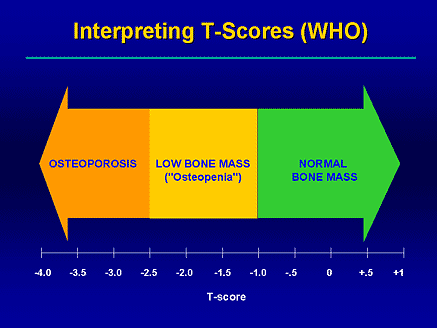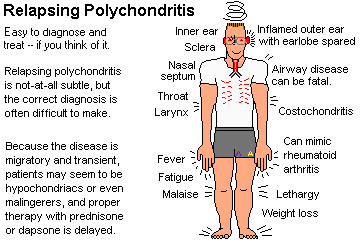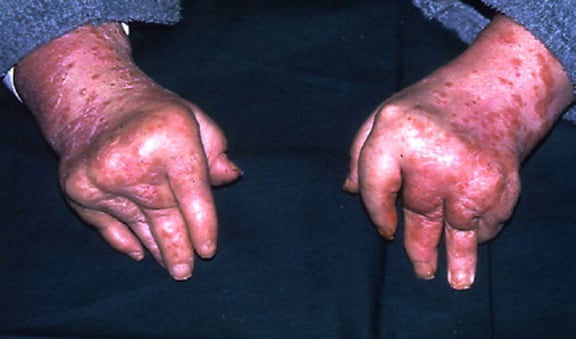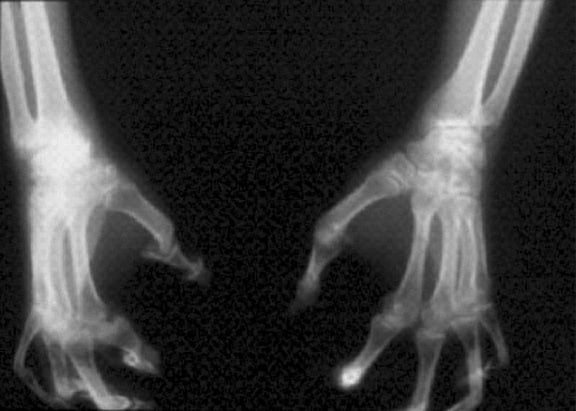
Total Pageviews
Showing posts with label Rheumatology. Show all posts
Showing posts with label Rheumatology. Show all posts
Sunday, 24 June 2012
Friday, 25 May 2012
Adult onset Still disease
- rare form of inflammatory arthritis
- begins after the age of 16 years
- diagnosis of exclusion
- serum ferritin is usually elevated
- RF and ANA are classically negative
- treatment: NSAIDs
- Yamaguchi's criteria

- begins after the age of 16 years
- diagnosis of exclusion
- serum ferritin is usually elevated
- RF and ANA are classically negative
- treatment: NSAIDs
- Yamaguchi's criteria

Wednesday, 23 May 2012
Relapsing polychondritis
- characterised by inflammation of cartilage (ear, nose and laryngotracheobronchial tree)
- also manifested with scleritis, neurosensory hearing loss, polyarthritis, cardiac abnormalitis, skin lesion and glomerulonephritis
- most common in 5th decade
- systemic features such as fever, fatigue and weight loss precede the clinical signs by several weeks
- auricular chondritis is the most frequent presenting manifestation (40%), and eventually affecting 85% of patients
- typically involving pinna of ears and sparing earlobe because they do not contain cartilage
- treatment: prednisolone 40-60mg/day


- also manifested with scleritis, neurosensory hearing loss, polyarthritis, cardiac abnormalitis, skin lesion and glomerulonephritis
- most common in 5th decade
- systemic features such as fever, fatigue and weight loss precede the clinical signs by several weeks
- auricular chondritis is the most frequent presenting manifestation (40%), and eventually affecting 85% of patients
- typically involving pinna of ears and sparing earlobe because they do not contain cartilage
- treatment: prednisolone 40-60mg/day


Sunday, 20 May 2012
Takayasu's arteritis
- an inflammatory and stenotic disease of medium and large-sized arteries characterized by strong predilection for the aortic arch and its branches
- a.k.a aortic arch syndrome
- 2-3 per million
- 80% are women and mean age of onset is 30 years
- panarteritis with inflammatory mononuclear cell infiltrates and occasionally giant cells
- presents with fever, night sweats, arthralgia, anorexia and weight loss
- pulses are commonly absent in the involved vessels, particularly subclavian artery
- hypertension occurs in 32-93% of patients and contribute to renal, cardiac and cerebral injury
- diagnosis is confirmed by the characteristic pattern on arteriography which includes irregular vessel walls, stenosis, post stenotic dilatation, aneurysm formation, occlusion and evidence of increased collateral circulation
- corticosteroid with the addition of steroid sparing agents such as methotrexate or azathioprine are mainstay of treatment
- a.k.a aortic arch syndrome
- 2-3 per million
- 80% are women and mean age of onset is 30 years
- panarteritis with inflammatory mononuclear cell infiltrates and occasionally giant cells
- presents with fever, night sweats, arthralgia, anorexia and weight loss
- pulses are commonly absent in the involved vessels, particularly subclavian artery
- hypertension occurs in 32-93% of patients and contribute to renal, cardiac and cerebral injury
- diagnosis is confirmed by the characteristic pattern on arteriography which includes irregular vessel walls, stenosis, post stenotic dilatation, aneurysm formation, occlusion and evidence of increased collateral circulation
- corticosteroid with the addition of steroid sparing agents such as methotrexate or azathioprine are mainstay of treatment
Saturday, 25 February 2012
Henoch-Schonlein Purpura
- a.k.a anaphylactoid purpura
- small vessel vasculitis characterised by palpable purpura (usually over buttocks and lower extremities), arthralgia, gastrointestinal signs and symptoms and glomerulonephritis
- presumptive pathogenic mechanism for HSP is immune complex deposition (usually IgA)
- palpable purpura is seen in virtually all paediatric patients
- gastrointestinal involvement is characterised by colicky abdominal pain associated with nausea, vomiting, diarrhea or constipation frequently accompanied by passage of blood and mucus per rectum, bowel intussusception may occur
- diagnosis of HSP is based on clinical signs and symptoms
- skin biopsy : leukocytoclastic vasculitis
- excellent prognosis, 1-5% of children progress to ESRF
- treatment: prednisolone (1mg/kg) has been shown to be useful in decreasing tissue edema, arthralgia and abdominal discomfort
- patients with rapidly progressive glomerulonephritis have been anecdotally reported to be benefit from intensive plasma exchange combined with cytotoxic drugs

- small vessel vasculitis characterised by palpable purpura (usually over buttocks and lower extremities), arthralgia, gastrointestinal signs and symptoms and glomerulonephritis
- presumptive pathogenic mechanism for HSP is immune complex deposition (usually IgA)
- palpable purpura is seen in virtually all paediatric patients
- gastrointestinal involvement is characterised by colicky abdominal pain associated with nausea, vomiting, diarrhea or constipation frequently accompanied by passage of blood and mucus per rectum, bowel intussusception may occur
- diagnosis of HSP is based on clinical signs and symptoms
- skin biopsy : leukocytoclastic vasculitis
- excellent prognosis, 1-5% of children progress to ESRF
- treatment: prednisolone (1mg/kg) has been shown to be useful in decreasing tissue edema, arthralgia and abdominal discomfort
- patients with rapidly progressive glomerulonephritis have been anecdotally reported to be benefit from intensive plasma exchange combined with cytotoxic drugs
Thursday, 12 January 2012
Human leukocyte antigen (HLA)
- found on chromosome 6
- HLA corresponds to MHC class I (A,B and C)
- HLA corresponds to MHC class II (D)
HLA associations
- HLA DR2 : SLE
- HLA DR3 : autoimmune hepatitis, Sjogren syndrome
- HLA DR4 : Felty syndrome
- HLA DQ2 / DQ8 : coeliac disease
- HLA B27 : AS, Reiter's syndrome
- HLA Cw6 : psoriasis
- HLA B8 : myasthenia gravis
- HLA B5 / B51 : Behcet's disease

- HLA corresponds to MHC class I (A,B and C)
- HLA corresponds to MHC class II (D)
HLA associations
- HLA DR2 : SLE
- HLA DR3 : autoimmune hepatitis, Sjogren syndrome
- HLA DR4 : Felty syndrome
- HLA DQ2 / DQ8 : coeliac disease
- HLA B27 : AS, Reiter's syndrome
- HLA Cw6 : psoriasis
- HLA B8 : myasthenia gravis
- HLA B5 / B51 : Behcet's disease

Sunday, 1 January 2012
X-linked hypophosphataemic rickets
- dominantly inherited (transmitted by affected father to all daughter)
- defect in renal phosphate handling
- mutation in the PEX or PHEX genes which encode an endopeptidase
- rickets develops in early childhood and is associated with poor growth
- low phosphate, high PTH, high urine phosphate
- treatment: high dose oral phosphate and vitamin D (calcitriol)

- defect in renal phosphate handling
- mutation in the PEX or PHEX genes which encode an endopeptidase
- rickets develops in early childhood and is associated with poor growth
- low phosphate, high PTH, high urine phosphate
- treatment: high dose oral phosphate and vitamin D (calcitriol)

Tuesday, 13 December 2011
Familial mediterranean fever (FMF)
- autosomal recessive
- MEFV gene on chromosome 16 codes for pyrin/marenostrin (activate biosynthesis of chemotactic factor inactivator in neutrophils)
- recurrent attacks of fever, arthritis, serositis, pericarditis, peritonitis
- raised inflammatory markers
- associated with AA amyloidosis causing nephrotic syndrome
- treatment: colchicine

- MEFV gene on chromosome 16 codes for pyrin/marenostrin (activate biosynthesis of chemotactic factor inactivator in neutrophils)
- recurrent attacks of fever, arthritis, serositis, pericarditis, peritonitis
- raised inflammatory markers
- associated with AA amyloidosis causing nephrotic syndrome
- treatment: colchicine
Sunday, 4 December 2011
Inclusion body myositis
- idiopathic inflammatory myopathy occur usually in men over 50 years
- gradual muscle weakness (mainly distal)
- weakness finger/wrist flexors out of proportion to finger/wrist extensors and shoulder abductors and weakness of knee extensors disproportionate to the hip flexors (quadriceps and long finger flexors)
- weakness of pharyngeal muscle causes dysphagia in 50%
- mild CK elevation
- muscle biopsy: inflammation and basophilic rimmed vacuoles with diagnostic filamentous inclusions and vacuoles on EM
- IBM is refractory to steroid and immunosuppresive agents

- gradual muscle weakness (mainly distal)
- weakness finger/wrist flexors out of proportion to finger/wrist extensors and shoulder abductors and weakness of knee extensors disproportionate to the hip flexors (quadriceps and long finger flexors)
- weakness of pharyngeal muscle causes dysphagia in 50%
- mild CK elevation
- muscle biopsy: inflammation and basophilic rimmed vacuoles with diagnostic filamentous inclusions and vacuoles on EM
- IBM is refractory to steroid and immunosuppresive agents

Saturday, 26 November 2011
Juvenile idiopathic arthritis
- persistent oligoarthritis is the most common form of JIA (50-60%), four or fewer joints are affected (knees, ankles and wrist). Uveitis is common with positive ANA and seen in younger girls (peak at 3 years old)
- polyarticular JIA affects older girls. 2 forms - rheumatoid factor positive or negative
- Still's disease presents with high fever, evanescent pink maculopapular rash with arthralgia, arthritis, myalgia and generalised lymphadenopathy. Autoantibodies are negative
- enthesitis related arthritis usually affects teenage boys, causing asymmetrical lower limb arthritis associated with HLA-B27 and risk of iritis

- polyarticular JIA affects older girls. 2 forms - rheumatoid factor positive or negative
- Still's disease presents with high fever, evanescent pink maculopapular rash with arthralgia, arthritis, myalgia and generalised lymphadenopathy. Autoantibodies are negative
- enthesitis related arthritis usually affects teenage boys, causing asymmetrical lower limb arthritis associated with HLA-B27 and risk of iritis

Thursday, 17 November 2011
DMARDs side effects
Methotrexate
- marrow suppression, hepatic fibrosis, pneumonitis
Sulfasalazine
- leukopenia & thrombocytopenia, rash and macrocytosis
Hydroxychloroquine
- retinopathy
Gold
- given by IM
- pancytopenia, lung fibrosis, cholestatic jaundice, glomerulonephritis, angioneurotic edema, exfoliative dermatitis
Penicillamine
- drug-induced lupus, proteinuria, loss of taste, pancytopenia
Leflunomide
- diarrhea, nausea, alopecia, rash
Sunday, 6 November 2011
Cryoglobulinemia
- cryoglobulins are immunoglobulins and complement components which precipitate reversibly in cold, which leads to small vessel damage and deposition on the wall of small vessel result in generalised vasculitis
- presents with purpura, arthralgia, leg ulcers, Raynaud's phenomenon, polyneuropathy, asymptomatic proteinuria, microscopic hematuria or nephrotic syndrome
- skin most commonly involved (>90%) - reticulated skin pattern of microthrombosis and areas of gangrene
- management : plasma exchange, high dose steroid, chemotherapy (cyclophosphamide) and treatment of underlying conditions
- 3 types are recognised
Type I
- monoclonal antibody (usually IgM)
- associated with multiple myeloma and lymphoproliferative disorder
- presents with acrocyanosis, Raynaud's phenomenon, retinal hemorrhage
Type II & III (mixed cryoglobulinemia)
- IgM or IgA with rheumatoid factor activity binds to polyclonal IgG
- type II is monoclonal ; whereas type III is polyclonal
- presents with glomerulonephritis (more common in type II), vasculitic rash and Raynaud's
- they can activate the classical pathway of complement and cause consumption therefore low C4 with normal C3
- associations: Hepatitis B and C, HIV, CMV, malaria, EBV, malaria, autoimmune disorder
* Meltzer's triad = Purpura + Arthralgia + Myalgia *
(Typically seen in polyclonal CG - hepatitis C)
- presents with purpura, arthralgia, leg ulcers, Raynaud's phenomenon, polyneuropathy, asymptomatic proteinuria, microscopic hematuria or nephrotic syndrome
- skin most commonly involved (>90%) - reticulated skin pattern of microthrombosis and areas of gangrene
- management : plasma exchange, high dose steroid, chemotherapy (cyclophosphamide) and treatment of underlying conditions
- 3 types are recognised
Type I
- monoclonal antibody (usually IgM)
- associated with multiple myeloma and lymphoproliferative disorder
- presents with acrocyanosis, Raynaud's phenomenon, retinal hemorrhage
Type II & III (mixed cryoglobulinemia)
- IgM or IgA with rheumatoid factor activity binds to polyclonal IgG
- type II is monoclonal ; whereas type III is polyclonal
- presents with glomerulonephritis (more common in type II), vasculitic rash and Raynaud's
- they can activate the classical pathway of complement and cause consumption therefore low C4 with normal C3
- associations: Hepatitis B and C, HIV, CMV, malaria, EBV, malaria, autoimmune disorder
* Meltzer's triad = Purpura + Arthralgia + Myalgia *
(Typically seen in polyclonal CG - hepatitis C)
Tuesday, 1 November 2011
Autoantibodies
- dsDNA : SLE
- anti-histone : drug-induced lupus
- anti-centromeric : limited scleroderma
- anti-Ro (SS-A) : SLE, primary Sjogren (anti-Ro only= SLE)
- anti-La (SS-B) : SLE, primary Sjogren
- anti-Sm : SLE
- anti-RNP : SLE, MCTD
- anti-Jo : polymyositis, dermatomyositis
- anti-Scl70 (topoisomerase 1) : diffuse scleroderma
Thursday, 27 October 2011
Erosive osteoarthritis

- A form of OA marked by greater degree of inflammation and characterised by presence of erosions on plain radiograph
- predominantly affects postmenopausal women
- classically affects PIPJ and DIPJ
- gull's wing or inverted T pattern of erosion is typical
- commonly confused with RA, but there is no juxtaarticular osteoporosis
Wednesday, 12 October 2011
Gonococcal arthritis
- commonest cause of septic arthritis in previously young fit adult
- more common in females and homosexual men
- presents with fever, characteristic rash/pustules, polyarthralgia and tenosynovitis, followed by large joint monoarticular arthritis.
- treatment: IV ceftriaxone, examination of joint and washout under anaesthesia

- more common in females and homosexual men
- presents with fever, characteristic rash/pustules, polyarthralgia and tenosynovitis, followed by large joint monoarticular arthritis.
- treatment: IV ceftriaxone, examination of joint and washout under anaesthesia

Retroperitoneal fibrosis
- a.k.a Ormond's disease
- more common in males and peak in 5th or 6th decade of life
- one of the multifocal fibrosclerotic syndrome (which involves mediastinal fibrosis, sclerosing cholangitis and Riedel thyroiditis)
- presents with low back pain (commonest), malaise, anemia, uremia (ureteric obstruction), raised ESR
- 2/3 idiopathic, associated with malignancy, drug (methysergide, practolol), radiotherapy, untreated AAA, SLE, scleroderma, carcinoid syndrome
- CT is best diagnostic modality
- treatment: steroid, azathioprine

- more common in males and peak in 5th or 6th decade of life
- one of the multifocal fibrosclerotic syndrome (which involves mediastinal fibrosis, sclerosing cholangitis and Riedel thyroiditis)
- presents with low back pain (commonest), malaise, anemia, uremia (ureteric obstruction), raised ESR
- 2/3 idiopathic, associated with malignancy, drug (methysergide, practolol), radiotherapy, untreated AAA, SLE, scleroderma, carcinoid syndrome
- CT is best diagnostic modality
- treatment: steroid, azathioprine

Tuesday, 11 October 2011
Wegener's granulomatosis
- granulomatous necrotizing vasculitis
- triad of
i) upper airways (granuloma) - rhintis (first sign), epistaxis, sinusitis, saddle nose (perforated septum), otitis, mastoiditis
ii) lungs (granuloma and vasculitis) - multiple pulmonary nodule (coin lesions), cavitating lesion with diffuse alveolar changes, presents with hemoptysis
iii) renal (vasculitis)- segmental crescentric necrotizing glomerulonephritis
- c-ANCA (PR3) positive (highly sensitive and specific)
- treatment: IV methylprednisolone, cyclophosphamide


Poor prognostic indicators
- presence and severity of renal involvement
- elderly
- pulmonary hemorrhage
- poor response to therapy at 2 weeks
- high degree of sclerosed glomeruli/interstitial scarring on biopsy
- triad of
i) upper airways (granuloma) - rhintis (first sign), epistaxis, sinusitis, saddle nose (perforated septum), otitis, mastoiditis
ii) lungs (granuloma and vasculitis) - multiple pulmonary nodule (coin lesions), cavitating lesion with diffuse alveolar changes, presents with hemoptysis
iii) renal (vasculitis)- segmental crescentric necrotizing glomerulonephritis
- c-ANCA (PR3) positive (highly sensitive and specific)
- treatment: IV methylprednisolone, cyclophosphamide


Poor prognostic indicators
- presence and severity of renal involvement
- elderly
- pulmonary hemorrhage
- poor response to therapy at 2 weeks
- high degree of sclerosed glomeruli/interstitial scarring on biopsy
Thursday, 6 October 2011
Felty's syndrome
mnemonic : "SANTA"
S: Splenomegaly
A: Anemia
N: Neutropenia
T: Thrombocytopenia
A: Arthritis (Rheumatoid)
- up to 3% of RA patients have Felty's syndrome
- 90% patients with Felty's syndrome are HLA DRW4
S: Splenomegaly
A: Anemia
N: Neutropenia
T: Thrombocytopenia
A: Arthritis (Rheumatoid)
- up to 3% of RA patients have Felty's syndrome
- 90% patients with Felty's syndrome are HLA DRW4
Arthritis mutilans
- rare form of psoriatic arthritis, found in 1-5% of patients
- resorption of bone (osteolysis) with dissolution of joint
- redundant overlying skin with a telescoping motion of joint
- X-ray: pencil-in-cup
- treatment: methotrexate


- resorption of bone (osteolysis) with dissolution of joint
- redundant overlying skin with a telescoping motion of joint
- X-ray: pencil-in-cup
- treatment: methotrexate


systemic vasculitis
Large vessels
- Takayasu's arteritis
- Giant cell arteritis
Medium vessels
- Kawasaki disease
- classical PAN
Small vessels
- Churg Strauss syndrome
- Wegener's granulomatosis
- Microscopic polyangitis
- Henoch Scholein purpura
- Essential cryoglobulinaemia


- Takayasu's arteritis
- Giant cell arteritis
Medium vessels
- Kawasaki disease
- classical PAN
Small vessels
- Churg Strauss syndrome
- Wegener's granulomatosis
- Microscopic polyangitis
- Henoch Scholein purpura
- Essential cryoglobulinaemia


Subscribe to:
Posts (Atom)